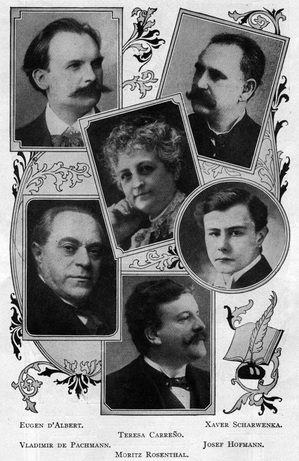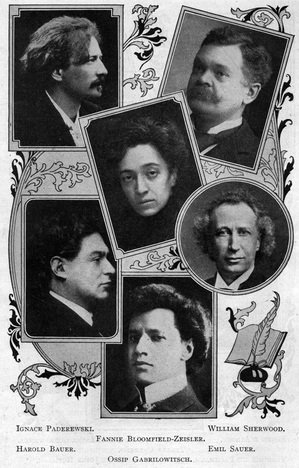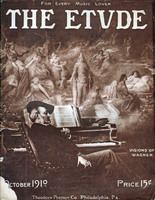(From the Standard History of Music)
By JAMES FRANCIS COOKE
[The following is specially arranged for The Etude from the above mentioned recently published work. These missionaries of the music of the present are often ignored in the pages of musical history, but their importance is really very great, for the musical history of to-morrow depends considerably upon the interpreters of to-day. Several of the forty story lessons from the Standard History of Music have been published in previous issues, and the following article refers to them.]
 We have learned of the pianists and piano teachers who have had a wide influence as teachers and composers; let us now consider some famous performers upon the piano, many of whom also have reputations as composers and as educators, but who are best known as virtuosos. In order that you may fix these great players more clearly in your mind, we will study them in groups, as taught by their famous masters.
We have learned of the pianists and piano teachers who have had a wide influence as teachers and composers; let us now consider some famous performers upon the piano, many of whom also have reputations as composers and as educators, but who are best known as virtuosos. In order that you may fix these great players more clearly in your mind, we will study them in groups, as taught by their famous masters.LISZT’S PUPILS.
We have already learned of Liszt’s famous pupils, Von Bülow, Raff, Klindworth, Mason, and others. The ones we are to consider now are hardly less famous.
Eugen d’Albert (dal’-bair), born in 1864 at Glasgow, Scotland, although famous for fame as a composer of the successful opera Tiefland. He is a pupil of Pauer, Stainer, Prout and Sullivan in London, Richter in Vienna, and Liszt in Weimar. His playing is strong, brilliant, and his technic remarkable.
Emil Sauer (sour), born in 1862 at Hamburg, was a pupil of his mother, then of Nicholas Rubinstein and finally of Franz Liszt. Sauer has not achieved great fame as a composer, but his playing is so remarkable that many consider him the greatest living virtuoso. His playing is poetical, yet vigorous, and shows a finely balanced artistic, feeling.
Moritz Rosenthal (ro’-sen-tahl), born in 1862 at Lemburg, a pupil of Mikuli (mee- koo’-lee), a pupil of Chopin, Joseffy and Franz Liszt. His technic is phenomenal and he is a virtuoso of the very highest rank.
William H. Sherwood, born in 1854 at Lyons, New York, is a pupil of Dr. Mason, Theodor Kullak, Deppé, Liszt and many others; highly successful as a virtuoso both in Europe and in America. He is a finished, scholarly player and an able teacher.
Other very famous pupils of Franz Liszt include: B. J. Lang, Reisenauer (ry’-sen- au-er), Bendel (bend’-dl), R. Burmeister, A. Friedheim, Adele Aus der Ohe (oh-eh), Sophie Menter, D. Pruckner, Meyer-Olbersleben, Sgambati (sgam-bah’-tee), Siloti, Stavenhagen, Karl Tausig (tow-sig), Emil Liebling, Edward Baxter Perry, Richard Hoffman.
LESCHETIZKY’S PUPILS.
Ignace Jan Paderewski (pah-der-ef’-skee), born in 1859 in Podolia, Poland, is the most famous living pianist; pupil of Raguski (rah-goos-kee) in Warsaw, of Wuerst (veerst) and Urban in Berlin, and of Leschetizky in Vienna. He is enormously successful in the United States and in England. His playing is reposeful, yet strong and vigorous; artistic, yet full of deep feeling and character. No virtuoso has ever had a greater power over audiences. His compositions include one opera, a symphony, and many fine pianoforte compositions.
Fannie Bloomfield-Zeisler (tseys’-ler), born in 1866 at Bielitz, Austria, was brought to America at the age of two, and was educated in this country. She ranks with Paderewski as one of Leschetizky’s greatest pupils. She is received with the highest enthusiasm by audiences in all parts of Europe and America, and is comparable with the greatest performers of all time. She has made two highly successful European tours.
 Ossip Gabrilowitsch (ga-bree-lo-vitsch), born in 1878 at St. Petersburg, was a pupil of both Rubinstein and Leschetizky. He is a very finished and poetical player, who has met with wide popular favor in America and in Europe.
Ossip Gabrilowitsch (ga-bree-lo-vitsch), born in 1878 at St. Petersburg, was a pupil of both Rubinstein and Leschetizky. He is a very finished and poetical player, who has met with wide popular favor in America and in Europe.Other famous Leschetizky pupils who are known in the United States are Katherine Goodson, Mark Hambourg. Annette Essipoff (ess’-i-poff), whom Leschetizky married, and Slivinski (slee-vin’-skee).
PUPILS OF OTHER NOTED TEACHERS.
Josef Hofmann (hoff’-man), born in 1877 at Cracow, Russia, was a pupil of his father, who was the teacher of harmony at the Warsaw Conservatory. Later he studied with Rubinstein. At the age of nine he astonished the musical world with a phenomenal tour of the great cities, after which he went into retirement, and again made his appearance at the age of seventeen, and has .since won wide recognition by his masterly playing.
Teresa Carreño (car-rehn’-yo), born in 1853 at Caracas, Venezuela, a pupil of Rubinstein, Gottschalk and Mathias, and a performer of wonderful skill, insight and force. She has been received in all the great cities of the musical world on equal terms with the foremost virtuosos of our time.
Xaver Scharwenka (shar-ven’-ka), born in 1850 at Samter, Poland, is a pupil of Kullak, and has made highly successful tours in Europe and America. He is now one of the heads of the Scharwenka-Klindworth Conservatory in Berlin. His compositions are many and include a fine pianoforte concerto, a symphony and an opera. His Polish Dance is one of the most widely known pianoforte pieces.
Vladimir de Pachmann (pahk’-mahn), born in 1848 at Odessa, has made a specialty of Chopin’s works and is unexcelled in the performance of them. He was a pupil of his father, and of Dachs at the Vienna Conservatory. Notwithstanding many eccentricities, he is a very great artist.
Raoul Pugno (poon’-yo), born in 1852 at Montrouge, France, is a brilliant pianist and a broad musician. He studied at the Paris Conservatory and took in succession the first prizes in piano, organ and harmony. In 1896 he became a professor of piano at the Conservatory. His compositions are quite numerous and show decided originality.
Leopold Godowsky (god-off’-skee), born in 1870 at Wilna, Russian Poland, is a pupil of the Royal High School of Music in Berlin. Later he studied with Saint-Saëns in Paris. He made two tours of America and taught in this country for several years. Returning to Europe, he met with still greater success as a teacher in Berlin and Vienna. His technic is so great that many feel he has reached the limit of human ability in this direction.
Harold Bauer (bower), born in 1873 at London, England, studied violin with his father and with A. Pollitzer, and made tours of England as a violinist for nine years. He determined to become a concert pianist and went to Paris to study with Paderewski. After only one year of study he toured Russia as a concert pianist and has since toured most of the countries of Europe and America with huge success. Bauer has a fine intellect and a very poetical nature, and his recitals have an appeal to the music-lover as well as the student.
Ferrucio Busoni (fare-rootch-chio boo-so’- nee), born in 1866 at Empoli. Italy, was first taught by his parents, who were both musicians, and later under W. A. Remy in Graz. His playing shows great breadth and a finely trained mind. His compositions and his arrangements of the works of Bach are excellent. Busoni taught for a time at the New England Conservatory, and has made many tours in Europe and in America.
Rafael Joseffy (yo-sef-fee), born in 1853 at Hunfalu, Hungary, was a pupil of Moscheles and Reinecke at the Leipsic conservatory, and of Tausig in Berlin. His delicacy of touch, combined with a very remarkable technic and musicianly understanding, made him one of the foremost virtuosos of our time. For over twenty years Joseffy has resided in America as a teacher.
Sergei V. Rachmaninoff (rach-mahn’-een- off), born in 1873 at Nijni-Novgorod, Russia., graduated from the conservatories of St. Petersburg and Moscow; pupil of Siloti (see- loh’-tee), Arenski and Janeiff. Although he has made successful tours as a pianist and as a conductor, he will be best known as a composer. Many look upon him as the greatest Russian since Tschaikowsky. His Prelude in C Sharp Minor is enormously popular. In 1910 he became the supervisor of all the leading conservatories of Russia.
TEN TEST QUESTIONS.
Name at least ten famous pupils of Franz Liszt.
Which famous German pianist is considered by many as the greatest virtuoso of our time?
Give the name of an American pupil of Liszt who has achieved fame both in America and in Europe.
For what is Rosenthal particularly famed?
Who is the most successful of all living virtuosos?
Which woman pupil of Leschetizky is regarded as one of the foremost living pianists?
Tell something of Leschetizky’s other famous pupils.
Name the countries in which the following famous pianists were born: Hofmann, Carreño, Scharwenka, De Pachmann, Pugno, Godowski, Bauer, Busoni, Joseffy.
Give the name of the best-known teacher of each of the foregoing.
Which famous pianist was a successful violinist before studying piano?



